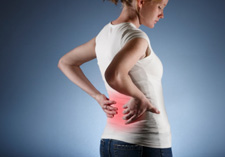
Back pain is surrounded by many myths
Back pain is surrounded my many social myths; this was very apparent when I was searching for an image to accompany this article. Most images were of people lifting poorly or being overweight. There were also many attempts to link all back pain with lumbar disc herniation—the ‘slipped disc’ which was commonly believed amongst healthcare practitioners in the 1950s. An enormous and confused industry has grown up around these back problems that in general terms offer little to help people prevent lower back episodes and ignores the obvious link between injury and fitness, or fine tuning, of the lower back.
A new study published in Arthritis Care & Research, a journal of the American College of Rheumatology, is very interesting in the data it provides on lower back injury but is conspicuous in its failure to provide an underlying link to these events.
The study undertaken by Sydney Medical School investigated the cause of lower back pain in 999 patients aged 18 years or older attending clinics in Sydney. They were asked what they had been doing in the four days leading up to the attack.
They found that ‘attacks of back pain’ are most likely to strike before lunchtime. Prof Manuela Ferreira of the Sydney Medical School, said around 40% of sprains and strains in the study occurred between 8am and 11am.
They found that when doing something physical:
- Being distracted increased the risk of pain 25 times.
- Being tired at the outset increased the risk of pain 8 times.
- In awkward postures, such as moving objects at a distance from the body, and involving other people or animals all increased the risk 6-8 times.
- Undertaking moderate or vigorous physical activity raised the risk 3 times.
- Fatigue or tiredness that developed whilst doing a physical task increased the risk 3 times.
- A 20 year old is 5 times more likely to injure themselves as a 60 year old.
Most importantly though, ‘there was no link between unexpected lower back pain and having sex or drinking alcohol,’ the Australian researchers said, which is just as well!
Their study is unique in that it demonstrated for the first time that even brief exposure to a range of physical and psychosocial factors can considerably increase the risk of back pain. Also that it is not just long term stresses on the back that lead to back pain.
Though this is an interesting and detailed study it is littered with unclear terms and colloquial phrases that show an underlying lack of understanding about how these ‘misfires’ occur.
The motor system of the lower back relies very heavily on information coming into the brain for it to make decisions on how to construct fine movements of the lower back. It is a ‘feedback loop’ where information goes in and is processed before information goes out to control the firing of very powerful muscles in the lower back.
This is why being distracted, being tired, being in an awkward position, having had vibration to the lower back (car trip), doing physical tasks which you are not used to and a host of other things confuses the feedback loop and results in a confused firing order of lower back muscles.
This is why it hardly ever happens during sex – there is a heightened nerve feedback during arousal improving the accuracy of the firing of the muscles of the lower back.
Chiropractic care is one of the most successful forms of care for lower back pain. This is because it specialises in detecting and correcting the feedback loop which in turn places your brain back in control so healing can occur when it wasn’t before.
